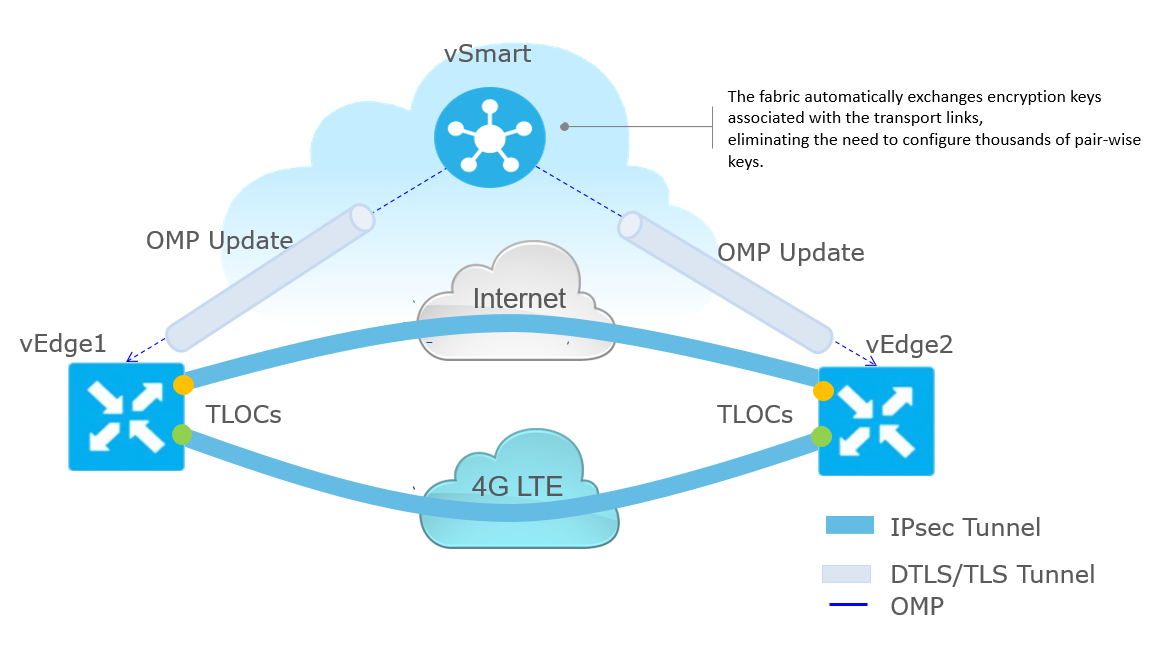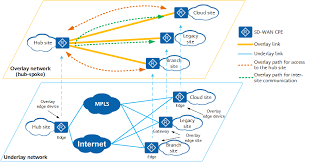In today's rapidly evolving digital landscape, SD-WAN technology stands out as a revolutionary approach to simplifying branch office networking and optimizing application performance over internet and hybrid WAN.
At the heart of this transformation lies the intricate dance between two critical components: overlay and underlay networks. Understanding the differences and interactions between these networks is not just technical jargon; it's the key to unlocking the full potential of SD-WAN solutions.
This blogpost aims to demystify the complex relationship between overlay and underlay networks.By breaking down the technicalities into easy-to-understand concepts, we'll explore how each network operates, their unique advantages, and how they work together to provide secure, efficient, and flexible connectivity across wide area networks.

Understanding Overlay Networks
Overlay networks play a crucial role in SD-WAN by implementing network virtualization. They create a "virtual" layer on top of the physical network, allowing for more flexible and efficient data routing. This is particularly useful in connecting branch offices, remote sites, and even cloud environments in a cost-effective manner.
One of the key features of overlay networks is their use of encapsulation protocols like VXLAN, GRE, and IPSec. These protocols wrap original data packets in a new header, which includes routing information for the overlay network. This method ensures that data can travel securely and efficiently across the underlying physical network, regardless of the underlying infrastructure.
A prominent example of overlay network usage is in SD-WAN architectures, where VPN functionality is leveraged to bypass expensive MPLS circuits. This approach not only reduces costs but also enhances connectivity among various sites by relying on the internet or other low-cost connections as the transport layer.
Similarly, cloud-native networking employs overlay networks to connect Virtual Private Clouds (VPCs) with enterprise locations, ensuring secure and reliable data flow across the internet.
However, overlay networks are not without their challenges. The dependence on the internet as an underlay network introduces potential security threats and latency issues. Yet, the benefits of software-driven network automation, VPN privacy, and the ability to abstract networking logic across multiple cloud providers make overlay networks a valuable tool in modern networking strategies.
By understanding and effectively utilizing overlay networks, organizations can achieve greater flexibility, cost savings, and improved network management capabilities, ensuring their networking infrastructure is robust, secure, and capable of supporting the demands of today's digital landscape.
For IT professionals and organizations looking to dive deeper into Cisco's approach to SD-WAN, particularly focusing on the practical applications and technical details, This course covers everything from the basics of SD-WAN to advanced configuration and management techniques.
For more information and to enroll, visit Cisco SD-WAN course.
Overlay vs. Underlay: Key Differences
Understanding the key differences between overlay and underlay networks is essential in grasping how SD-WAN functions. These differences highlight the unique roles each network layer plays in creating a robust and efficient networking environment.
- Encapsulation Requirements: Overlay networks require encapsulation, such as VXLAN, GRE, etc., to create a virtual network layer over the physical network. This contrasts with underlay networks, which do not need encapsulation because they are concerned with the physical routing of packets.
- Application Segregation: In overlay networks, segregating applications across different network segments is very easy and flexible. Underlay networks, being hardware-based, make application segregation very complex due to their rigid nature.
- Hardware vs. Software: The connectivity in underlay networks is hardware-based, relying on physical devices and infrastructure. Overlay networks, on the other hand, are software-based, offering more flexibility and ease of configuration through virtualization.
- Multi-path Forwarding: Overlay networks inherently support multi-path forwarding, allowing data to travel across multiple paths simultaneously for better load balancing and redundancy. In contrast, setting up multi-path forwarding in underlay networks is complex and often limited by the hardware's capabilities.
- Scalability: Due to their software-defined nature, overlay networks are more scalable than underlay networks. They can easily adapt to changes and grow with the organization’s needs without being bogged down by hardware limitations.
- Security: Security in overlay networks is enhanced through the use of encryption methods like IPSec, making public underlays like the internet secure for private traffic. Underlay networks, especially those utilizing the internet, are not inherently secure and can be vulnerable to threats.
- Deployment Time: Overlay networks allow for quicker deployment times. Adding and changing services in an overlay network can be achieved rapidly and with minimal physical intervention. Underlay networks, being dependent on physical hardware, have longer deployment cycles due to the need for manual setup and configuration.
Understanding these differences is crucial for anyone involved in network design, implementation, and management. It helps in making informed decisions that ensure the network is resilient, efficient, and aligned with the organization's needs.

Interaction Between Overlay and Underlay Networks
In the world of SD-WAN, overlay and underlay networks work together to ensure efficient, secure, and reliable data transmission across the entire network. Understanding their interaction is crucial for optimizing network performance and leveraging the full potential of SD-WAN technologies.
Foundation and Support: The underlay network acts as the foundation, providing the physical connections between different network points, such as routers, switches, and the broader internet. On top of this foundation, the overlay network forms a virtual layer, enabling more advanced routing, security, and network segmentation capabilities.
Data Encapsulation and Transmission: Overlay networks encapsulate data packets, adding a header with routing information specific to the virtual network. These encapsulated packets are then transmitted over the underlay network. This process ensures that data can traverse different types of physical networks (like the internet, MPLS, or LTE) securely and efficiently.
Control and Management: The overlay network, being software-defined, provides a centralized control mechanism. This allows network administrators to manage routing, policies, and security settings across the entire network from a single pane of glass. The underlay network, meanwhile, handles the actual data transport, obeying the rules and routes defined by the overlay network.
Scalability and Flexibility: The interaction between overlay and underlay networks offers unmatched scalability and flexibility. As business needs change, network administrators can adjust the overlay network's configuration without needing to make physical changes to the underlay infrastructure. This ability to adapt quickly is a key advantage of SD-WAN technologies.
Troubleshooting and Performance: Monitoring the interaction between overlay and underlay networks is essential for troubleshooting and optimizing network performance. Issues in the underlay network, such as packet loss or high latency, can affect the performance of the overlay network. Therefore, having visibility into both layers helps in diagnosing and resolving issues more efficiently.
In essence, the synergy between overlay and underlay networks is what makes SD-WAN solutions so powerful. By abstracting the complexity of the physical network and providing a flexible, software-defined overlay, businesses can enjoy enhanced performance, better security, and greater agility in their networking infrastructure.
Summary
Understanding overlay and underlay networks is crucial for leveraging SD-WAN effectively. Overlay networks offer flexibility and security, making it easier to manage and scale network services. Underlay networks provide the essential physical infrastructure that carries overlay traffic, impacting performance and reliability.
Integrating these networks in SD-WAN allows for a robust, adaptable networking solution that meets modern demands for security, efficiency, and cost-effectiveness. However, success requires careful planning and optimization to navigate the complexities of modern network environments.
This exploration highlights the importance of both network types in creating comprehensive, high-performing network strategies. As technology evolves, so too will the approaches we use to connect and secure our digital worlds.


